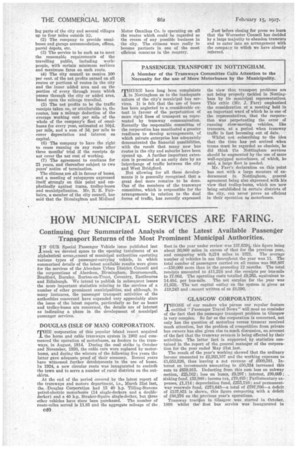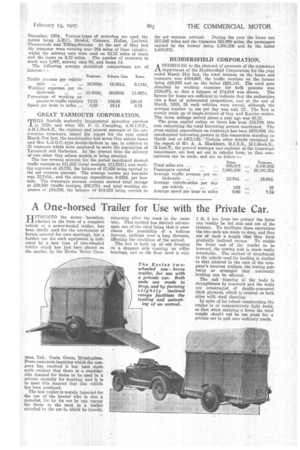HOW MUNICIPAL SERVICES ARE FARING.
Page 62

Page 63

If you've noticed an error in this article please click here to report it so we can fix it.
Continuing Our Summarized Analysis of the Latest Available Passenger Transport Returns of the Most Prominent Municipal Authorities.
IN OUR Special Passenger Vehicle issue published last week we devoted space to the opening instalment of an alphabetical arrangement of municipal authorities operating various types of passenger-carrying vehicle, in which summarized details of the latest available results were given for the services of the Aberdare Urban District Council and the corporations of Aberdeen, Birmingham, Bournemouth, Bradford, Burnley, Burton-on-Trent, Coventry, Eastbourne and Edinburgh. We intend to publish in subsequent issues the more important statistics relating to the services of a number of other prominent municipalities, and although, in many instances, the passenger transport activities of the authorities concerned have expanded very appreciably since the issue of the latest reports, particularly so far as buses and trolley-buses are concerned, the details are of interest as indicating a phase in the development of municipal passenger services.
DOUGLAS (ISLE OF MAN) CORPORATION. THE corporation of this popular island resort acquired the horse and cable tramways system in 1902 and commenced the operation of motorbuses, as feeders to the tramways, in August, 1914. During the coal strike in October and November, 1920, the cable cars were replaced by motorbuses, and during the winters of the following five years the latter gave adequate proof of their economy, Recent years have witnessed further developments in the use of buses. In 1924, a new circular route was inaugurated to encircle the town and to serve a number of rural districts on the outskirts.
At the end of the period covered by the latest report of the tramways and motors department, i.e., March 31st last, the Douglas Corporation had 15 40 h.p. Tilling-Stevens petrol-electric motorbuses (14 single-deckers and a doubledecker) and a 40 h.p. Straker-Squire single-decker, but three other vehicles have since been purchased. The number of route-miles served is 11.85 and the aggregate mileage of the
fleet in the year under review was 157,634 this figure being about 30,000 miles in excess of that for the previous year, and comparing with 9,274 miles in 1921. The average number of vehicles in use throughout the year was 11. The total number of passengers carried on all routes was 968,807 —150,000 more than in the preceding 12 months. The total receipts amounted to £11,224 and the receipts per bus-mile to 17.06d. The operating costs totalled £9,265, equivalent to 14.48d. per bus-mile. The net surplus for the year was £1,959. The net capital outlay on the system is given as £19,243 and :mount written of as £8,396.
GLASGOW CORPORATION.
THOSE of our readers who peruse our regular feature entitled "Passenger Travel News" will need no reminder of the fact that the passenger transport problem in Glasgow is very complex. So far as the corporation is concerned, not only has the question of motorbus versus tramcar received much attention, but the problem of competition from private bus owners has also given rise to much discussion, on account of the fact that the tramway revenue is being effected by their activities. The latter fact is supported.. by statistics contained in the report of the general manager of the corporation for the year ended May Slst last.
The result of the year's working showed that the ordinary income amounted to £2,263,107 and the working expenses to 11,653,526, thus leaving a net revenue of £609,581. Interest on investments amounting to 150,334 increased this sum to 1659,915. Deducting from this sum loss on subway section, £25,562; loss on buses, £9,297; interest, £99,609; sinking fund, 155,9461 income tax, £79,485; Parliamentary expenses, £1,114; depreciation fund, £253,110; and permanentway renewals fund, £273,643—a total of £797,766—a deficit of 1137,851 is shosvia this figure comparing with a deficit of 180,276 on the previous year's operations.
Tramway traction in Glasgow was started in October, 1898 whilst the'. first bus service was inaugurated in December, 1924. Various types of motorbus are used, the makes being A.E.C., Bristol, Commer, Halley, Leyland, Thornycroft and Tilling-Stevens. At the end of May last the tramcars were running over 264 miles of lines (single), whilst the subway cars were used on 13.12 miles of route and the buses on 8.12 miles. The number of tramcars in stock was 1,087, subway cars 50, and buses H.
The following average statistical comparisons are of interest :—
Traffic revenue per vehicleTramcars. Subway Cars. Buses.
mile ... 16.909d. 19.861d. 9.134d.
Working expenses per ve hicle-mile 13.01.9d. 20.850d, 11.697(1. Percentage of working ex penses to traffic receipts 73.21 104.98 128.07 Speed per hour in miles ... 8.59 10.14 9.73
GREAT YARMOUTH CORPORATION.
THIS Norfolk authority inaugurated motorbus services in 1920, and when Mr. P. G. Campling, A.M.I.E.E., A.M.I.Mech.E., the engineer and general manager of the corporation tramways, issued his report for the year ended March 31st last, the municipality had seven Guy saloon buses and thre L.G.O.C.-type double-deckers in use, in addition to 35 tramcars which were employed to serve the population of Yarmouth add Gorleston. At the present time the delivery of two other Guy saloon models is being awaited.
The bus revenue account for the period mentioned showed traffic receipts at £11.515 (total receipts, £11,553)) and Working expenses at £8,733, the balance of £2,820 being carried to the net revenue account. The average income per bus-mile was 12.743d., and the average expenditure 9.633d. per busmile. The tramways revenue account showed total incotpe at £39,160 (traffic receipts, 018,175) and total working expenses at E24,230, the balance of £14,923 being carried to the net revenue account. During the year the buses ran 217,585 miles and the tramcars 552,880 miles, the passengers carried by the former being 1,500,269 and by the latter 4,419,632. "
HUDDERSFIELD CORPORATION.
ACCORDING to the abstract or accounts of the tramways department of the Huddersfield Corporation for the year ended March 31st last, the total revenue on the buses and tramcars was £304,687, the traffic receipts on the former being 08,926 and on the latter £231,141. The total sum abserbed by working expenses for both systems was
£230,073, 'so that a balance of £74,614 was shown. The figures for buses are suffident to indicate that the authorities run a fleet of substantial proportions, and at the end of March, 1926, 35 such vehicles were owned, although, the average number in use per day was only 23. The fleet is mostly made up of single-deckers of Guy and Karrier makes. The route Mileage served about a year ago was 45.32.
The gross capital outlay on buses has been £18,780, this sum comprising the total borrowing powers sanctioned. The gross capital expenditure on tramways has been £670,056, the =exhausted borrowing powers in this connection standing in March last at £472,142. Certain other details contained in
the report of Mr. A. A. Blackburn, M.I.Mech.E., M.Inst.T., the general manager and engineer of the tramways department, are best set out in tabular form, so that comparisons can be made, and are as follow :—












































































































